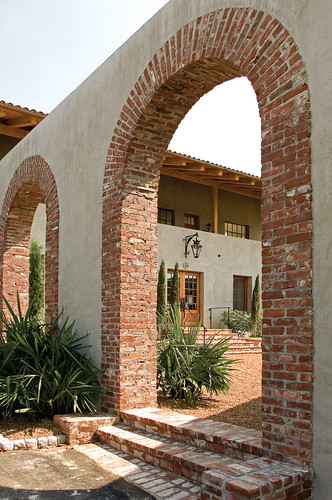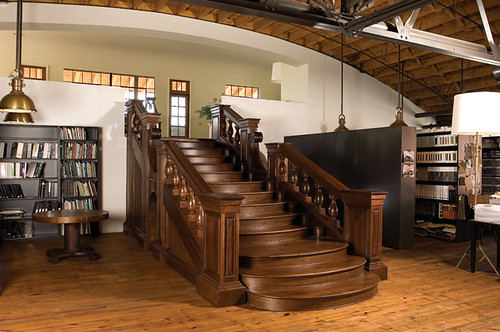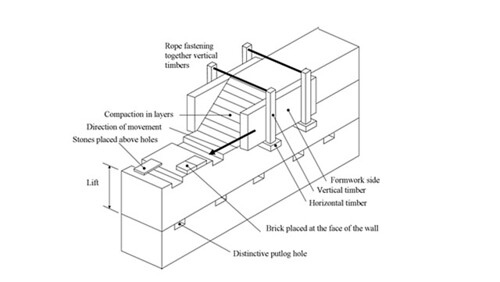A few weeks ago I had the pleasure of meeting with Keith Summerour. If you read this blog, you know what a thrill that was for me. He gave me a tour around his building. I was amazed. It's gorgeous. It's near Atlantis Station, but you would never know it.
So this picture shows it within the context of it's surroundings...
Once you walk in the courtyard it's like being in a different world!
Aren't these arches beautiful?
Can you imagine walking up these stairs every day? How could you not be inspired?
The stairs are a copy of Michelangelo’s Laurentian Library stairs in Florence, Italy.
My favorite part about this space is the exposed ceiling and the windows. There is such amazing light in here.
So, as I was talking to Keith I officially decided he's a genius. You can see his genuine passion shine through when you talk to him! We sat and talked for a while, and he told me about this article he wrote about rammed earth. It was not something I had ever really thought about, but the more I listed to him, the more excited I got about it. For me, that's the mark of an exceptional person, when their passion is contagious.
I asked if I could share the article with you guys, because I had an inkling it would be every interesting to you are well, and Keith was nice enough to say yes! So here it is...
Rammed Earth Walls For The Farm By: Keith Summerour
In the never ending search for cost effective, yet substantial construction techniques, I am forever finding that our predecessors had perfected cost efficient, locally supplied buildings long before modern construction technology entered the scene. In fact, one of the oldest, most long lived erection concepts is the use of dirt. That’s right, soil when compacted to 50% of its normal volume becomes 60% the strength of concrete and lasts, well, practically forever. This ancient building type has been employed for thousands of years. Sections of the Great Wall of China, churches, plantation houses and garden walls have used this method throughout human history.
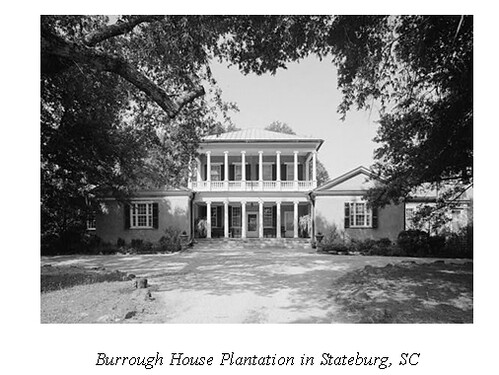

In the United States, rammed earth structures were exposed to the public through a book by S.W. Johnson named “Rural Economy” in 1806. Rammed earth buildings lost popularity and were soon forgotten as a construction method after World War II when there was a need for quickly constructed houses and manufactured material costs dropped significantly due to industrial output for the war effort.
Today there are the same sound reasons to employ rammed earth technology in constructing a shelter or fence/wall as in the past – it is your materials from your land, it is very energy efficient, uses only locally supplied resources (it is sustainable) and fast (taking 2/3’s the time of typical masonry structures) and is very durable (you are making man made sedimentary rock).
 What you need to know:
• Soil type - The best is 70% sand, 30% clay with low organic content. Georgia soil is ideal as long as there is not too much clay.
• Testing soil for suitability – Form a ball of mud and drop from 3’-0”. The amount of disintegration indicates its viability.
• Formwork (see diagram) – Two 3/4” plywood forms or metal concrete pan forms. Very well braced.
What you need to know:
• Soil type - The best is 70% sand, 30% clay with low organic content. Georgia soil is ideal as long as there is not too much clay.
• Testing soil for suitability – Form a ball of mud and drop from 3’-0”. The amount of disintegration indicates its viability.
• Formwork (see diagram) – Two 3/4” plywood forms or metal concrete pan forms. Very well braced.
• Tamping (Ramming) – Use pneumatic tamping devices, compress soil to 50% of the its original volume.
• Time Costs – Four people can erect 300 square feet per workday
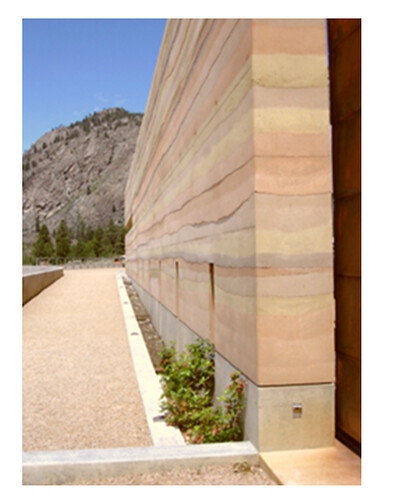
Rammed earth structures can provide an exciting, cost efficient alternative to purchasing manufactured materials and also provide a unique flavor to your rural landscape. In this time of economic uncertainty, you can always count on your land, your soil and your efforts to build structures that last. Where to learn more: • Easton, David. The Rammed Earth House. Chelsea Green Publishing Co., 1996 • McHenry, Paul Graham. Adobe and Rammed Earth Buildings: Design and Construction. University of Arizona Press, 1989
Thank you Keith!
So, what do you guys think? Have you ever seen any rammed earth structures? Do you think they could ever work here in Atlanta?


